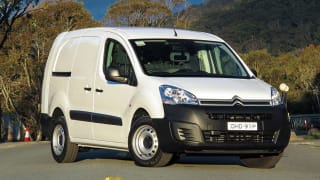Compared to the Caddy SWB Van previously tested, there’s been a big reduction in the cabin noise caused by tyre roar through the rear wheel arches. VW says no specific noise insulation has been added, so we can only attribute this acoustic gain to the noise-absorbing properties of the extra seat upholstery and perhaps the extra load floor covering and wall linings resulting from the longer wheelbase. The cabin noise is almost car-like at highway speeds, with conversations between front and rear occupants not requiring raised voices.
In city and suburban traffic the Crewvan is an agile and nippy performer, thanks to firm and responsive handling tied to a willing engine that’s so refined you sometimes need to look at the tacho when stopped at traffic lights to confirm it’s still running.
There’s excellent response from standing starts even with a full crew on board, and between 60-80km/h the engine is always operating within its 1500-3500rpm peak torque band, resulting in instant throttle response where you need it most in city and suburban driving..
The seven-speed dual-clutch automatic is a delight to use, with seamless up-shifting under acceleration and enthusiastic down-shifting when braking on inclines to ensure the engine is always in the right ratio when you get back on the accelerator.
We loaded 565kg into the cargo bay which, with a near-full tank of petrol and a driver, added up to a payload just under its maximum 725kg rating. The rear leaf springs compressed almost 60mm under this load, with the large tapered rubber cones engaged with the rear springs as they’re designed to do.
Although the rear end felt like it was suspended more by rubber than steel, it maintained its composure over the bumps with no noticeable change in steering response or braking efficiency. On the highway it did its best work in auto mode on the cruise control, maintaining the 110km/h limit at 2400rpm with automatic shifts back to sixth at 2800rpm, and sometimes fifth at 3400rpm, to easily clear hills while keeping within its broad torque curve.
It also made light work of our 2.0km, 13 percent grade climb with this payload, maintaining the 60km/h limit in fourth gear at 2600rpm. However, like the SWB Van, there was a faint whiff of hot oil after we stopped at the top, but there were no warning lights or chimes to alert that anything was wrong so we can only assume it’s normal.
Engine braking on the way down was minimal, as you’d expect with such a small engine trying to restrain such a large load. Fortunately, the four-wheel disc braking is exceptionally strong and if anything can bite too hard if you don’t ease pressure on the brake pedal when running empty or with light loads.

















